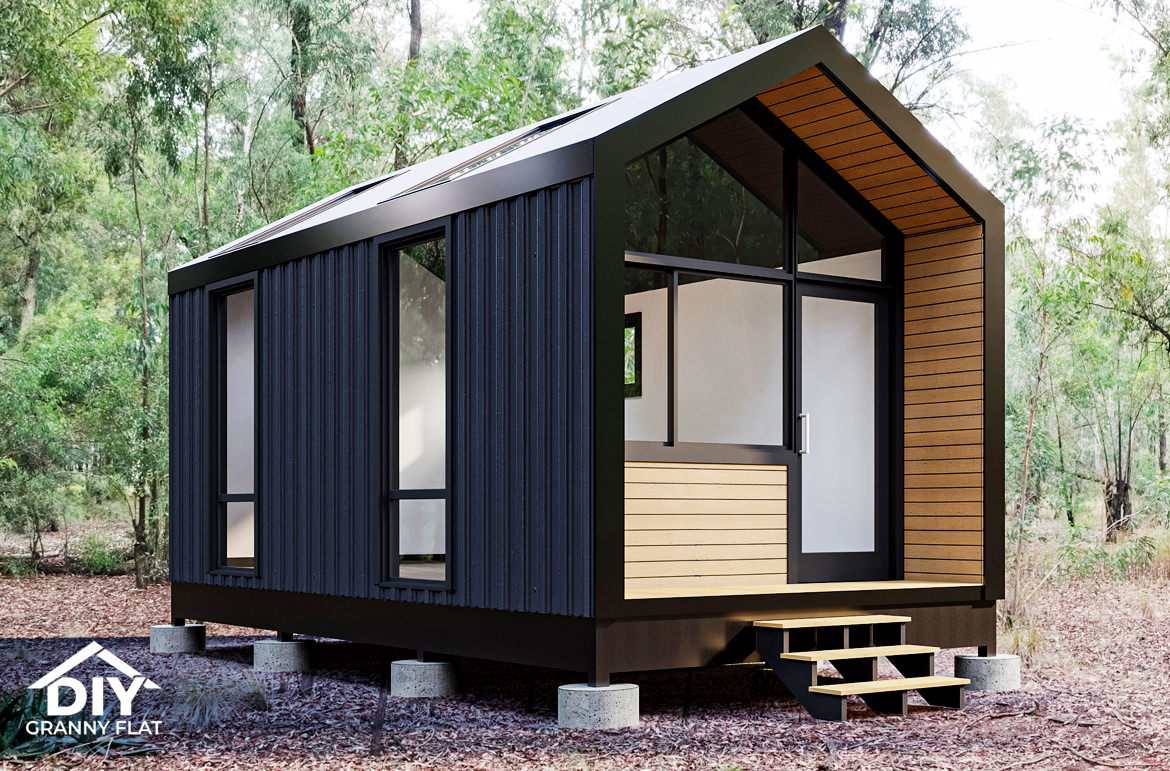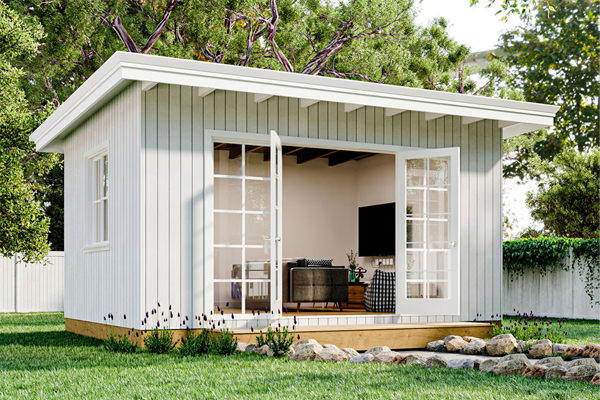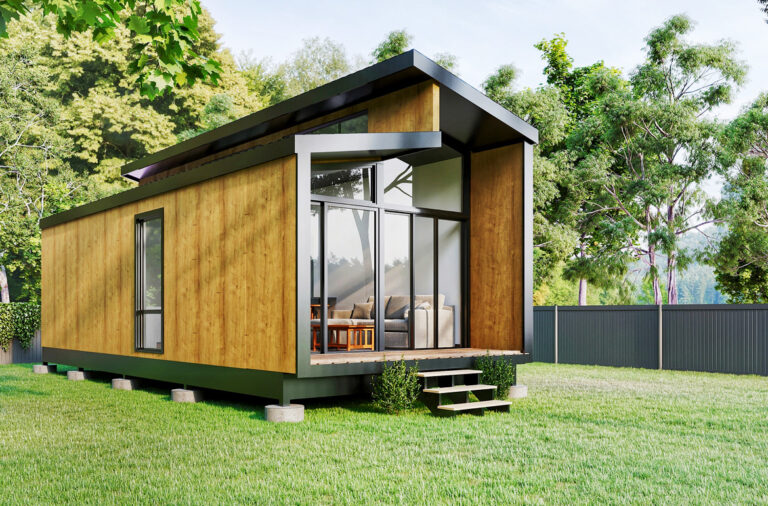
A question often asked is can I build a backyard cabin without approval?
The answer – yes, but only if you intend to use the cabin as a non-habitable room, and it is under the floor area limit for your state. If so, it can then be exempt from Council approval.
Today we will go over how much backyard cabins cost, and what permits they require. Then let you know what you can use the cabin for, and if your neighbours can make complaints about it. Finally, we will discuss whether it is better to crane one in, or build on site.
DON'T PAY A FORTUNE FOR YOUR GRANNY FLAT. Find out how to deal with council and build a granny flat for the lowest cost possible. Learn More.
Let’s not waste any time – let’s start discussing what you can and can’t do with your backyard cabin.
How Much Do Backyard Cabins Cost
Backyard cabins come in a range of prices for every budget. We have seen them advertised anywhere from $19,500 for a build it yourself one bedroom cabin, to $94,500 for one-bedroom built to the turnkey stage.
A good page to look at which runs you through pricing is here.
Or, you can also look at our designs, to see what you can see what you can get for what price. Our range consists of 8 different cabins, and they, along with their prices, are listed below, with a link included so that you can look into them further if you wish. Here are 3 of our popular ones:
Cabin 1 = $23,650
Cabin 2 = $36,300
Cabin 3 = $27,830
Have fun exploring your options.
What Permits Are Needed for a Backyard Cabin
This gets a little confusing, as not only does every Council have different regulations, but so does every state in Australia.

Getting the rules right mean you can transform your backyard
But, the good news is that not every cabin will require a permit from your local Council – that is, if it is under a certain size. These sizes are:
- NSW – In residential zones, no bigger than 20sqm.
- VIC – Not exceeding 10sqm.
- WA – No larger than 10sqm.
- SA – No bigger than 15sqm.
- QLD – No more than 10sqm.
- ACT – If your block is under 500sqm, a maximum of 10sqm. If between 500sqm to 600sqm, a maximum of 25sqm. Or if bigger than 600sqm, a maximum of 50sqm.
- NT – If it is located a minimum of 40m from all boundaries, and the building height is under 2.1m, a maximum roof area of 12sqm. If located a minimum of 70m from all boundaries, and the height is less than 2.4m, a maximum roof area of 30sqm.
- TAS – Up to 18sqm.
These cabins have an exemption from having to get a Council permit. However, I do suggest that you call your Council just to check these sizes, as they will differ from Council to Council. You can also have a further look into the legislation for NSW here.
It also depends upon what you intend to use your backyard cabin for. If staying under these sizes, you are essentially building a small backyard cabin to be used for non-habitable purposes, so you may be exempt from having to get planning permission. But if your intended use is normal day-to-day domestic activities, you will be required to submit documentation to your Council. So again, it’s best just to check with your Council prior to building whether you need their approval.
Moving on, your cabin will still require a permit of sorts, even if it’s not a permit from Council.
Let me clarify.
There are 2 main permits that are usually required to build a backyard cabin. These are:
- A Council planning permit, and
- A building permit or Construction certificate in some States.
As we have discussed, in many cases, if under a certain size, your backyard cabin will not require a Council planning permit, but will still always need a building permit.
Applying for a building permit is not too expensive – nowhere near as costly as removing or getting approval for an illegal building. It also covers you for the future. By having a building permit you are able to have your cabin insured properly.
Can I Use the Cabin for Whatever I Like
Unfortunately not.
In accordance with the National Construction Code (NCC), a backyard cabin is a Class 10 building – a smaller single dwelling, that is classified as being uninhabitable. This is another reason why you can get away without having to get Council approval – as they are not to be used for habitable purposes.
One of the main reasons that they are classed as not being habitable is as your standard backyard cabin does not come with a bathroom. Due to this, your Council will not allow you to live in them long-term, or rent them out. However you will be allowed to use them for short-term accommodation, if the occupant has access to the bathroom in the main home.

Working from home – Is the new norm these days.
So, what are you allowed to do with them, and what do most people use them for? They have plenty of uses, including as a:
- Home office.
- Workshop.
- Man cave or ‘She’ shed.
- Retreat for teenagers.
- Storage room.
- Guest room for overnight stays.
- Music studio.
- Gym or place to practice yoga.
- Kids play room.
- Garden shed.
- Art studio.
- Cooking room.
- Place to camp the night (a ‘sleep out’).
- Pool house.
Can Neighbours Complain About My Cabin
So, let’s say that you have neighbours that you really do not get along with, as they may be quite demanding and difficult, or in general you just tend to disagree upon things. And as a result, they are making you nervous about building a cabin without getting prior approval, because you are wondering whether they can complain to your local Council about it, once it has been built.
Well, your neighbour can complain all they want – but you do not always have to listen. As long as you adhere to all the regulations for building, and have not broken any local planning restrictions, you have done nothing wrong, so there is really nothing that they can do.
The only time there may be an issue is if you have really encroached upon the permitted regulation for building your cabin. Meaning, pay attention to your measurements from their boundary line, and the maximum height allowed for the cabin (which, in NSW, is no higher than 3m above the existing ground level).
If you are wanting to build the cabin very close to their boundary line, and the height exceeds the height limit, you should have gained planning approval prior to beginning building.
So, say you are doing so – going to the Council to ask for planning approval to build a cabin that is very tall, and very close to your very difficult neighbours boundary line. Can they then make a complaint and stop you from building?
Well, they can make a complaint, but it will be very hard for their objection to be upheld. It has to have a burden behind it that is weighty, something that affects them severely. For example, if you were asking to put the cabin directly in front of a window of theirs, then they have a right to make a serious complaint.
Other things they have a right to complain about are you blocking their views and or their source of natural light. If you are blocking any light coming into their windows, as you are building close to their house, then they may have room to complain.
But they cannot complain just because they don’t like you, or don’t like the building, as the complaint won’t be upheld. So you really shouldn’t be too worried about this, so long as you build the cabin to every regulation.
Crane One In vs. Building On Site, Which is Better?
When buying a cabin, there are three choices that you have for installing the building. These are to:
- Build on site from scratch as an ‘owner-builder‘.
- Pay for an off-site construction system, where the cabin is made in the manufacturers factory, and delivered to your site in pieces, so you can then assemble it on site. These are known as ‘flatpacks’, or also often referred to as ‘kit homes’.
- Have the cabin built in full at the manufacturers workshop, and when complete (known as a prefabricated building), have it craned into your backyard.
Both come with their advantages and disadvantages, which I will go over now.
Building on-site takes a lot longer – whether you choose to build it yourself from scratch or have a ‘kit home’ delivered.
Other disadvantages of ‘kit homes’ include they:
- Have things not included in the kit but are necessary for the build.
- Aren’t delivered immediately – it takes an average of 8 weeks from the time you order to date of delivery.
- Can be quite small, so you may have to order more than one to make the size cabin you want. This can also make the costs of transportation increase.
- Are not built to your land – no one has been out and assessed your site and built a cabin making best use of your location.
- Are tricky to make any changes/alterations to personalise them.
To get more of an idea on kit homes, and whether they are the right choice for you, you can read our article on them here.
Otherwise, you can look into building yourself from scratch – this can save you money, and you can design it yourself. Read more in our blog about the rules to build as an owner builder.
Moving on to prefabricated buildings. If you choose to purchase a prefabricated cabin, this will be delivered already made, so once it arrives, it is ready to go. It will be put in place, checked for any defects, if any are found these will be fixed, and all that is left to do is connect it to your utilities. So it can be fully installed and ready to use in just hours, whereas building can take months.
Craning is a good idea if access to your backyard is limited. But if you have sufficient space, all you will need is a hi-ab truck. These cost roughly $750 in metro regions, or an additional 75c/km on top in areas outside. A crane is costly, but as you are saving time, you may save money on the build. The cost will depend upon the size of the crane you require, but be sure to get a few quotes, as the majority of crane operators in Australia charge $400 an hour or more for their full-size cranes.
There’s also a lot more planning and organisation required to transport a prefabricated building than just hiring a crane. This includes:
- Plotting the route that is to be driven so that this is approved, as the streets you have them intending on driving must be safe for an oversized vehicle. Traffic control may even be required for high-risk or busy roads.
- Preparing your foundation, footings, and connections (water, power, and other utilities) in advance, so they are ready for when the cabin arrives.
For more insight into how to transport for a pre-built cabin, read our article, “Transporting a Granny Flat – How It Works & How To Save Money”.
Conclusion
A backyard cabin can be a good investment, as it can be used for several different things. It can also be a cheaper build than a granny flat, as Council approval is not always required.
So if you want something smaller in your backyard, and are happy for it to be an uninhabitable building, a cabin is something you can definitely consider building yourself or having pre-built and delivered.
DON’T PAY A FORTUNE FOR YOUR CABIN. Find out how to build a cabin for the lowest possible price. Learn More.










